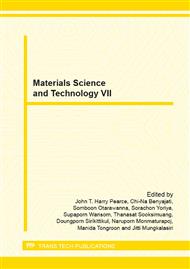p.177
p.182
p.188
p.193
p.197
p.211
p.219
p.225
p.230
Effects of Sintering Time and Atmosphere on Mechanical Properties of Injection Molded Tungsten Alloy
Abstract:
Tungsten is a promising refractory metal suitable for applications in which wear resistance, thermal stability and high weight are needed. In this work, the tungsten feedstock (94wt%W with balance of Ni-Cu-Co alloy) was used to form tensile test specimens by using metal injection molding (MIM) process. The molded specimens were debinded by catalytic debinding technique to convert to the brown specimens. After debinding, the brown parts were sintered under vacuum atmosphere (10-5 bar) with varied sintering times at sintering temperature from 1350 to 1450°C. The specimens sintered at 1450°C for 3 hours provided optimum sintered density and mechanical properties. The results showed that mechanical properties of the specimens sintered at 1450°C dramatically decreased when sintering times were longer than 3 hours. The specimens sintered at 1450°C for 8 hours showed brittleness. Physically, inferior mechanical properties were attributed to wettability and porosity of the binder phase. Chemical analyses were performed with the sintered W-(Ni-Cu-Co) specimens by using energy dispersive spectroscopy with mode of quantitative analysis. The specimens sintered at 1400°C for 3 hours showed high W content (28.95 wt. %) dissolved in the Ni-Cu-Co binder. However, penetration of the liquid binder was incomplete. The specimens sintered at 1450°C for 3 hours showed higher W content (34.28 wt. %) dissolved in the Ni-Cu-Co binder (with lower Cu content). Distribution of Cu was uniform across the whole specimen. Wetting of the liquid binder on W grains was complete without porosity. The specimens sintered at 1450°C for longer than 3 hours showed less W content (< 28.95 wt. %) dissolved in the Cu-depleted Ni-Co binder. Porosity was observed in the binder phase and in W grains. Sintering between W grains was also observed. Effects of different sintering atmospheres were also investigated. It was found that increasing the sintering chamber pressure caused detrimental effects on both physical and mechanical properties of the sintered tungsten specimens. In addition, nitrogen atmosphere gave similar results to those for increased chamber pressure.
Info:
Periodical:
Pages:
197-208
Citation:
Online since:
March 2013
Keywords:
Price:
Сopyright:
© 2013 Trans Tech Publications Ltd. All Rights Reserved
Share:
Citation:


